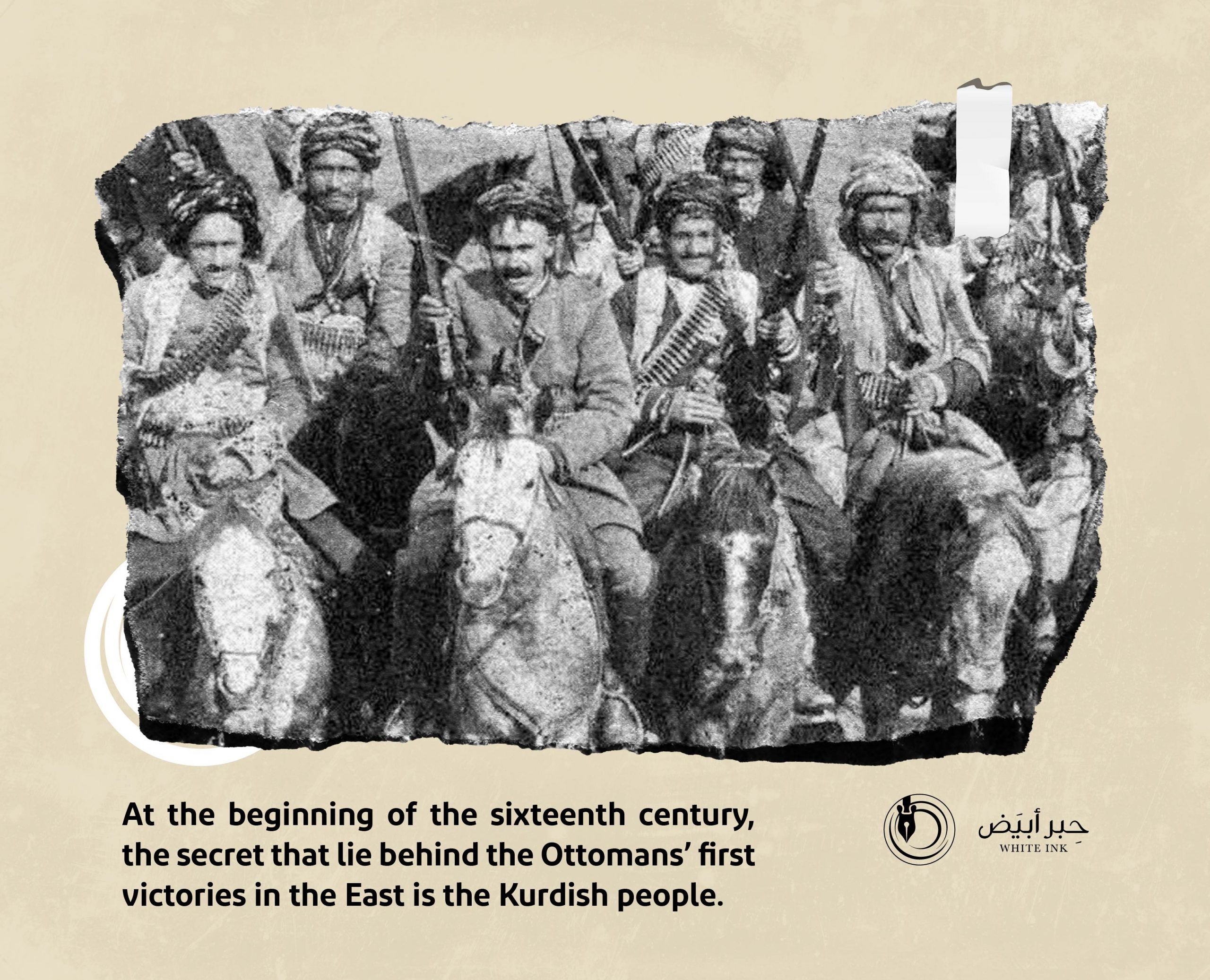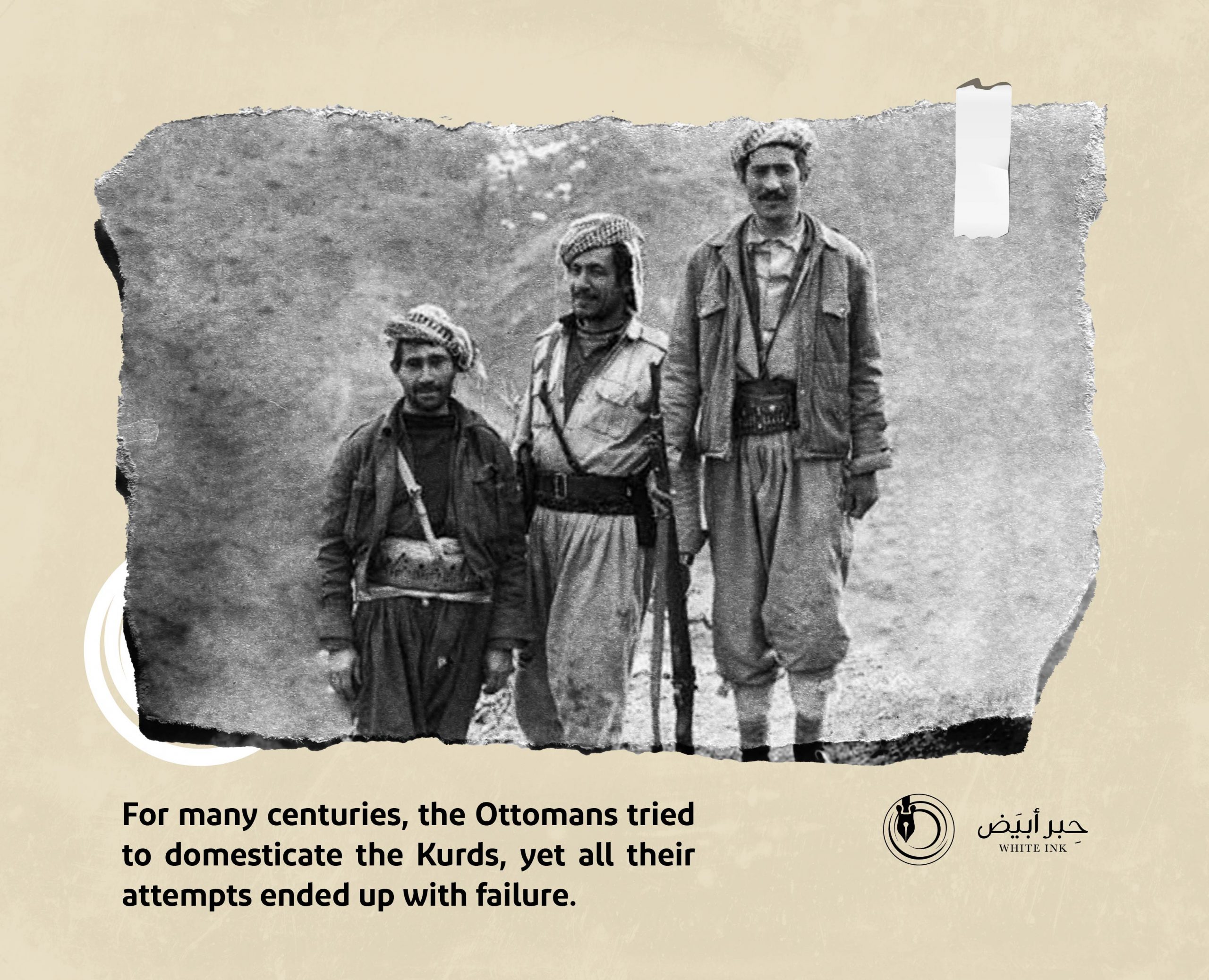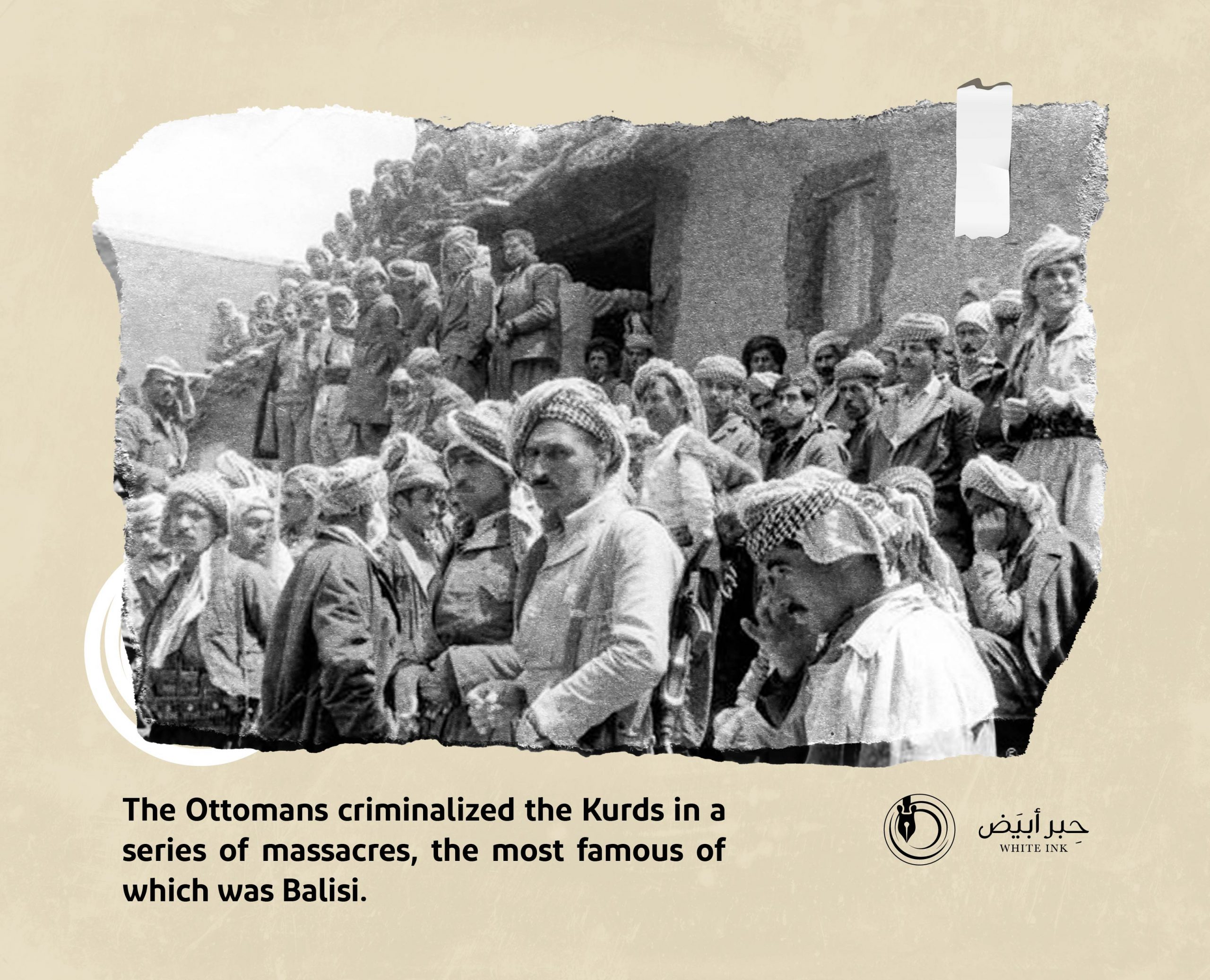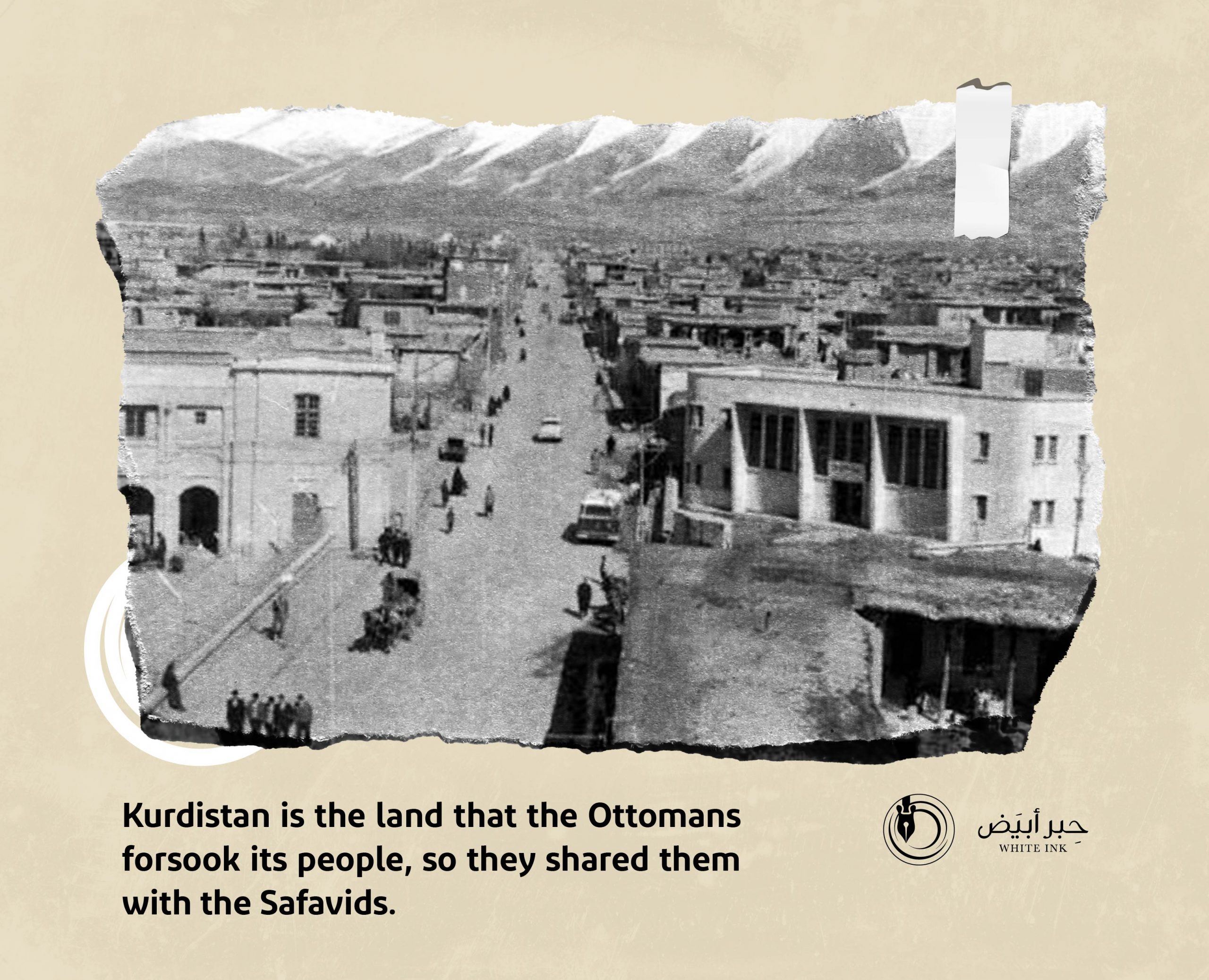
After the Magnificent revoked his father’s covenants
The Ottomans used the Policy of
Divide and Conquer to
infiltrate the Kurdish unity
Geography and history shaped the homeland of the Kurds and outlined its political profile throughout history. The location of the Kurds’ settlement, its mountainous terrain, the unlimited space, in addition to their widespread geographical distribution have effectively contributed in making them at a crossroads in the relationship with the major surrounding countries.
Perhaps the location of Kurdistan in the area between the Safavid state and the Ottoman Empire brought the Kurds into the midst of a global conflict, or rather put them between a rock and a hard place, there is no escape or way-out from it, for example: When the Safavid state became a threat to the Ottoman state since the fifteenth century AD, the homeland of the Kurds was the battlefield between the two countries. Historical sources indicate that the Ottoman Empire declared war on the Safavid state upon its expansion at the expense of the Turkmen state of the “Aq Qoyunlu” White Sheep” and the subsequent gains and expansion in the Kurdish regions, which Shah Ismail al-Safawi (1501-1524) considered a vital area for his state, accordingly several Kurdish Emirates were subject to him; such as the Emirate of “Hakkari” and other Kurdish emirates, where he handed them over to the Qizilbash instead of the Kurds, and forced them to leave the Sunni sect and embrace the Twelver sect, within a comprehensive sectarian policy that was followed throughout the lands controlled by the Safavids, to that end, they used repression, excessive brutality and terrorizing the inhabitants, and harnessing the material and military capabilities of the Kurdish emirates for the benefit of the Safavid state; in the context of those Safavid expansionist policies in Kurdistan and Asia Minor, the Ottomans realized the danger of Safavid expansion within the borders of their eastern state; therefore, the war between the two states broke out.
The Ottomans deceived the Kurds and worked on subjugating them.

After Sultan Selim I (1512-1520) secured Europe’s side militarily, he declared war against the Safavid state and marched with his army in (1514) to eastern Anatolia, until he reached the city of “Garmik” and there, he deployed a number of leaders of the left wing of his army, under the Kurdish prince Mustafa Bey commands. The so-called Mustafa Bey later became a minister in the Ottoman Empire. Both of the Ottoman and Safavid parties tried to have the Kurdish princes on their side, but Sheikh Idris Al-Badlisi’s efforts paid off by convincing a number of princes of the Kurdish Emirates that they would not lose their independence if they submitted to the Ottomans; most of them chose the Ottoman camp. There, the Ottoman and Safavid armies met in (23-8-1514) in the Chaldiran plain in the north-east of Lake Van; the battle ended with the Safavids suffered a major defeat; the Kurds played a major role in that battle, where about sixteen Kurdish princes joined this battle. The submission of the Kurdish Emirates to the Ottoman state lasted until the reign of Sultan Suleiman the Magnificent (1520-1566), and those emirates maintained their autonomy and appointed officials, governors, and administrators from the Kurds themselves. The Kurdish historian, Prince Sharaf Khan Al-Badlisi, mentions in his book “Al- Sharafnama” that the Kurdish Emirates during the Ottoman era were self-governed. The left bank of the western Euphrates River and all areas of the eastern bank of the Murad Su River, one of the branches of the Euphrates, were under the rule of the Kurdish Emirates. The Kurds offered obedience and gifts to the sultan, performed the work requested by the sultans, and provided reserve armies when needed.
Despite the independence of those emirates and their affiliation with the Ottoman authorities, they were carrying out revolutionary movements against the Ottomans. The military campaigns of the Ottoman authorities against the Kurdish revolutionaries, succeeded, by finding some agents to strike the Kurds from the inside, by applying the Divide and Conquer Policy. It is an effective policy used by the Magnificent with some Kurdish Emirates to limit their ambitions and movements against the Ottoman authorities, for example, but not limited to what he did with one of the Kurdish princes of Baban, as a rival appeared, supported by the Ottomans shortly after his accession to the emirate. As a result of such policy, the Magnificent appointed the first Turkish governor in his reign over Kurdistan, to eliminate the rule of the Kurdish princes and their various emirates after they used to inherit the throne of their emirates by heredity.
When the Ottomans sought the Kurds’ help, they granted them independence then turned against them.



- Ibrahim Al-Daqouqi, The Kurds of Turkey, 2nd Edition (Erbil: Aras Publications, 2008).
- Ahmed Abdul Rahim Mustafa, On the Origins of Ottoman History (Cairo: Dar El-Shorouk, 1982).
- Basili Nikitin, The Kurds: A Sociological and Historical Study, translated by: Nuri Talabani, 2nd Edition (Beirut: Dar Al-Saqi, 2001).
- Saadi Othman Hruti, Kurdistan and the Ottoman Empire: A Study of the Influence of Ottoman Domination Policy (Erbil: Mokiriani Foundation for Research and Publishing, 2008).
- Kameran Abdul Samad Al-Dosky, Kurdistan in the Ottoman Era (Beirut: Arab Encyclopedia House, 2006).
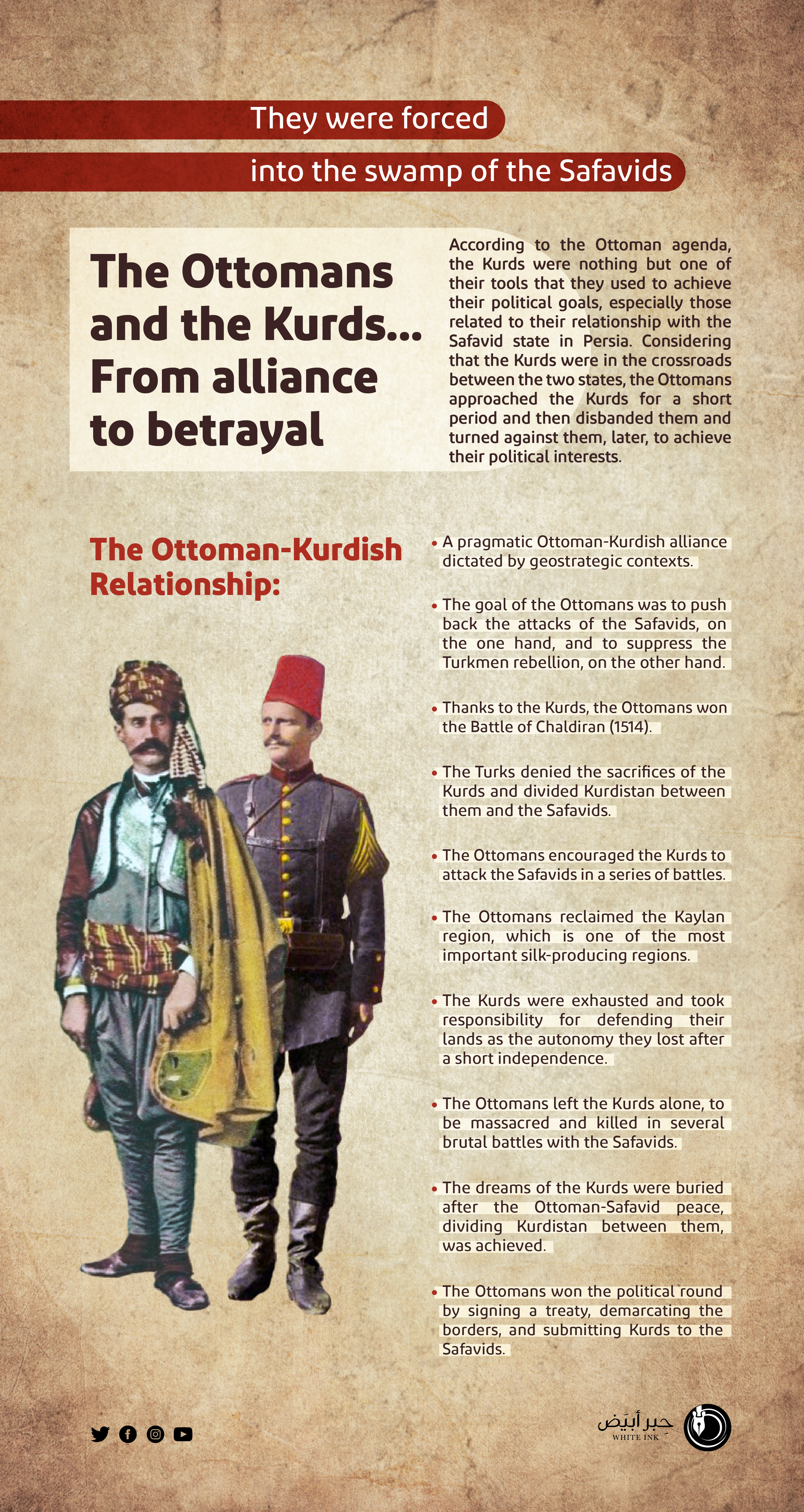
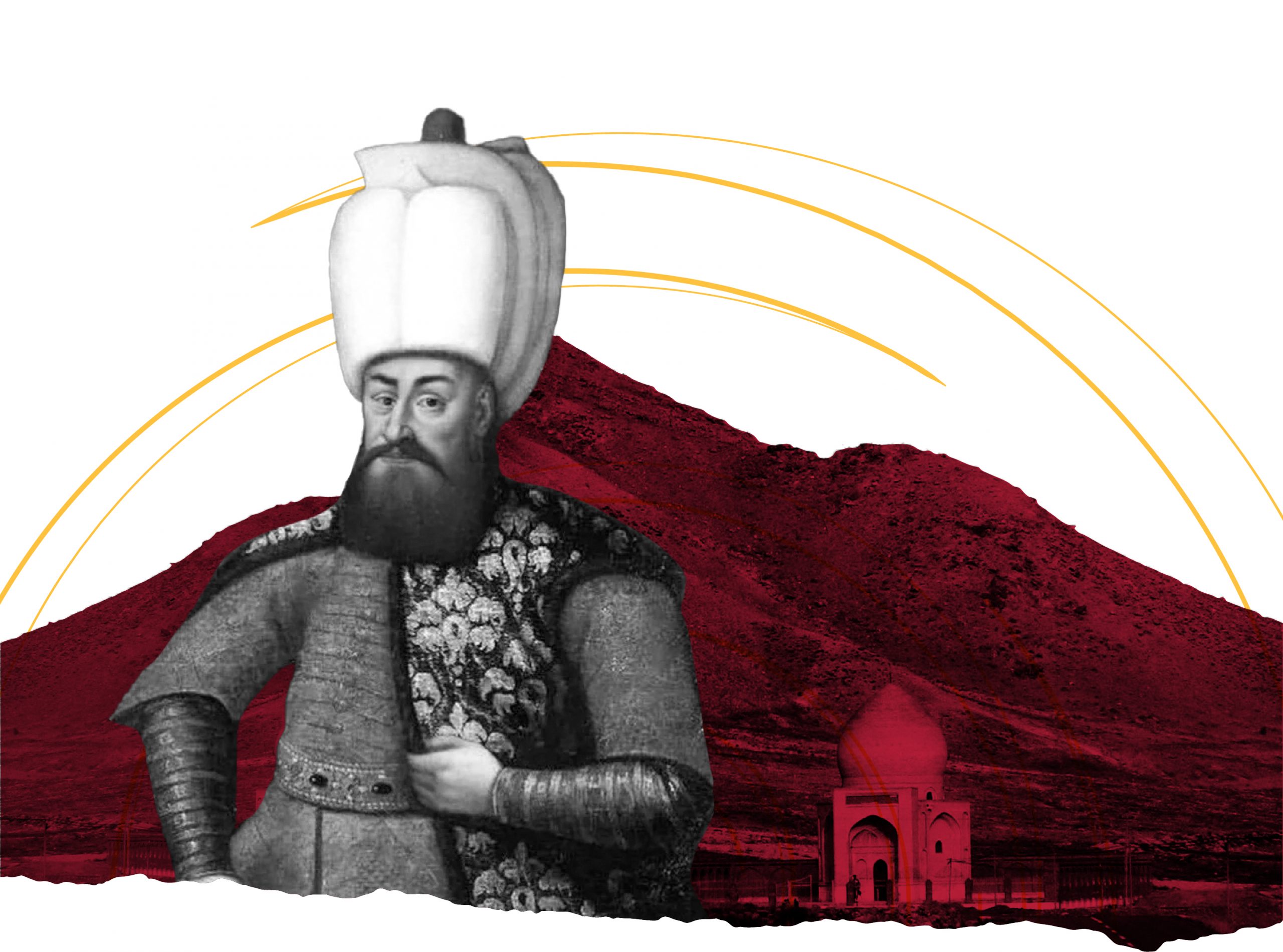
Murad III repeated their betrayal with Safavids
Ottomans Used the Policy of
“Needle Stings”
with the Kurds
Turkish Ottomans violated the rights of Kurdish people. Violation did not stop by occupying their lands and exploiting them to strengthen their state, then make a coup against them and abuse them; it went beyond as yesterday’s allies were sacrificed and left alone facing the Safavid terror machine, especially during the reign of Ottoman Murad III. Perhaps geography has caused Kurdish people to be between two colonial powers that turned their land into a field of war operations whose worst results were destroying several Kurdish cities and villages.
In his book “Documentary Studies of Modern History and Civilization of Kurds” (Dirasat Wathaekaya Fi Tarikh Al- Kurd Al- Hadith W Hadarathim), Imad Abdulsalam Ra’of described the important period of history of the triangular relations between Ottomans, Safavids and Kurds saying, “Such early stage of Baban history remained far from being recorded by historians, as well as the interest of writers and travelers. Had it not been for what we read in Sharafnama, a historical stage of at least three centuries would have been forgotten”.
With reference to the approved historical documents, we find that Ottomans and Kurds entered into pragmatic allies which were imposed by geostrategic contexts of the stage with the purpose of pushing the attacks of Safavids on one hand. On the other hand, it was also because of the desire of Ottoman sultans to strengthen domestic front in light of the rebellion of Turkmens and their refusal to be subject to the logic of state. Ottomans were able to settle their war against Safavids in the Battle of Chaldran in (1514) thanks to the strong support of Kurds who fought on their side. However, they denied all these sacrifices and divided Kurdistan between themselves and Safavids.
Ottomans dealt coldly with the plight of Kurds facing the brutality of Safavids.

On the other hand, Kurds saw that Ottomans were the best ally against the ambitions of Turkmen Aq Qoyunlu (white sheep, Sunni), as well as Qara Qoyunlu (black sheep, Shia), who controlled important areas of Kurdistan lands. However, the leader of Aq Qoyunlu, at that time Hasan Al- Taweel expressed his desire to Turkify all Kurdish tribes and unite Turkmens under one political umbrella whose capital was Diyarbakir.
In this context, one of the advantages of Ottoman/ Kurdish coordination was the conviction of Ottoman sultans to allow Kurds to conduct their affairs with some kind of independence from the central administration. This represented an advanced model of autonomy which will remain a constant demand of Kurds up to the present day. Such demand have been facing, for long decades, a categorical rejection on the side of Ankara rulers who wanted to forcibly subdue Kurds by ice and fire, away from any openness or desire to meet the legitimate demands of Kurds, given the privacy of Kurdish character and culture.
It can be said that the situation of “fragile peace” which characterized the dealings of some Turkish sultans with Kurds will come to an end when Ottoman sultan, Murad III, took over ruling in (1574). This made separation during the stage of Ottoman/ Kurdish coexistence despite the strategic importance of Kurdistan region. Thus, we find that Evliya Chalabi stated, in his book “a Journey to Egypt, Sudan and Abyssinia” (Rehla Ela Misr, Sudan, and Habasha), “people of states call the ruler Khan… had it not been for the existence of Kurdistan as a dam between Ottomans and Persians, Ottomans would not have achieved stability because Persians were a brave vigorous opponent”.
It is worth noting that the policy of Sultan Murad III came to complete the chapters of suffering which Kurds experienced, before, in a bloody confrontation against Ismail Al- Safawi who tormented Kurds and saw them as ideological enemy who cannot be trusted. Regarding this point, Mohammed Amin Zaki stated in his book “Summary of the History of Kurds and Kurdistan from the Oldest Historical Ages until Now” (Kholaset Tarikh Al- Kurd W Kurdistan Min Akdam Al- Osour Hata Al- An), “The era of Shah Ismail and his history with Kurds were similar to the era of Aq Qoyunlu Turkmen. They were eras of sever injustice and aggression because Kurds were Sunnis so they were neither trusted nor confided, unlike Turkmen who were extremist Shias and Rafidah. Therefore, he did not leave an opportunity without inflicting great harm to Kurds”.
In return, it seems that Ottomans were afraid that Kurds would achieve absolute independence from Istanbul in light of political situations which were moving towards expanded “decentralization” regarding the dealing of Kurds with the ruling of Ottoman sultans, especially that Kurds demonstrated high combat efficiency in the wars of Ottomans topped by the wars of annexing Cyprus Island. Some accounts indicate that they were the center of gravity of Ottoman army. This proposition is confirmed by Imad Abdulsalam stating that “the presence of Shahrizor governor among the greatest leaders of this campaign indicated that Kurdish princes and their fighters were working under his command. In addition, they were also the main center of gravity not regarding the island (i.e. Cyprus) conquest, but with regard to maintaining it when he became its governor, unlike the rest of the other leaders”.
This ambiguous relationship between the center and periphery was described by Mohammed Amin stating, “In sum, all Kurds voluntarily and willingly entered the ruling of Ottomans… so, there came these measures and systems which aimed at the country progress under Kurdish emirates and local administrations which contained Ottoman sovereignty”.
At the geostrategic level, the reign of Murad III coincided with the deterioration of security situation within the borders of Safavid state, especially with Qizilbash incursion and their control of Safavid political decision making. This fact prompted Ottomans to incite Kurds to launch attacks on Safavid lands with desire to decrease borders of the enemy neighbor and expand their borders. This proposition is confirmed by Abbas Ismail Sabbagh in his book, “History of Ottoman- Iranian relations” (Tarikh Al- Elakat Al- Othmania Al- Irania), who stated, “In the midst of these turmoils, Khosrow Pasha incited Kurds to attack the lands of Safavid state”.
However, the encouragement of Turks to Kurds to attack Safavids made them respond to these attacks and abuse Kurds in a series of battles including those fought by Safavids in order to retrieve Kilan region in (1591) as it was one of the most important silk production areas. Meanwhile, Ottomans took no action as Murad III was satisfied by only sending correspondence to Shah Abbas to give amnesty to Khan Ahmed, governor of Kilan. That request was refused by Shah Al- Safawi as he was aware of Ottomans ambitions in Kilan.
In line with the above, during the reign of Murad III, Ottomans turned a blind eye to the Safavid attacks which targeted Kurdish lands with the purpose of achieving two strategic goals. The first was causing exhaustion to Kurds in the face of Safavids and making them the responsibility of defending their lands considering that the defense responsibility was a “self- responsibility”. Thus, Ottomans were not obligated- in their view- to defend them and the borders of their states. The second goal was to exploit such move of Safavids which was weak compared to the strength of Turkish Ottomans at that time; then, force them to sign a treaty of demarcation between the two parties to serve the expansion goals of Ottoman Empire.
Turks have sacrificed their Kurdish friends and left them as a victim that was severely and cruelly abused.

It seems that Ottoman strategy succeeded to expand its borders at the expense of Kurdish tribes and clans through agreements to divide Kurds between the two imperial powers. This forced the dreams of Kurds to maintain areas which were governed according to the political model of autonomy. Regarding this point, in the same reference, Mohammed Amin stated, “In (1589/ 998 AH) Sinan Pasha Ghakhala Zada marched from Baghdad to Iran and invaded it up to Hamadan. This forced Shah Abbas to delegate Mirza Haider to travel to Astana asking for peace with Ottomans in order to put an end to the long wars whose battles took place between the two parties for several years. A peace treaty was concluded in Nowruz in (1590/ 998 AH) which required that the states of Azerbaijan, Shirvan, Kyrgyzstan, Lorestan, and Shahrazur shall be subject to Ottoman Empire,in addition, Shia sect shall be abolished and eliminated in all countries”.
In general, it can be said that Murad III opposed the autonomy privilege which was granted to Kurds. They were prevented from expanding at the expense of Turkish lands while moving to exhaust Safavids through intermittent battles which were similar to “needle stings” so that he would benefit, after that, from the reaction of Safavids who destroyed Kurdish areas. Thus, they gave a justification to Ottoman Sultan to intervene and force Safavids to negotiate according to his terms, the most important of which was to release Shia Turkmen whom he made, by force, subject to the Turkish central ruling after they posed a serious threat to Ottoman national security. Thus, Murad III was able to kill three birds with one stone: weaken Kurds, subjugate Turkmen and impose his privileged conditions to Safavids.
Ottomans have divided Kurdistan with Safavids forgetting the Kurdish epics in Chaldiran.



- Evliya Chalabi, “a Journey to Egypt, Sudan and Abyssinia”, translated by: Hussain Mugib Al- Masry (Cairo: Dar Al- Afak Al- Arabia, undated).
- Abbas Ismail Sabbagh, “History of Ottoman- Iranian relations”, war and peace between Ottomans and Safavids (Beirut: Dar Al- Nafaes, 1999).
- Imad Abdulsalam Ra’of, “Documentary Studies of Modern History and Civilization of Kurds”, (Damascus: Dar Al- Zaman for Printing, Publishing and Distribution, 2012).
- Mohammed Amin Zaki, “Summary of the History of Kurds and Kurdistan from the Oldest Historical Ages until Now”, translated by: Mohammed Ali Awni, 2nd (Baghdad: the General House of Cultural Affairs, 2005).
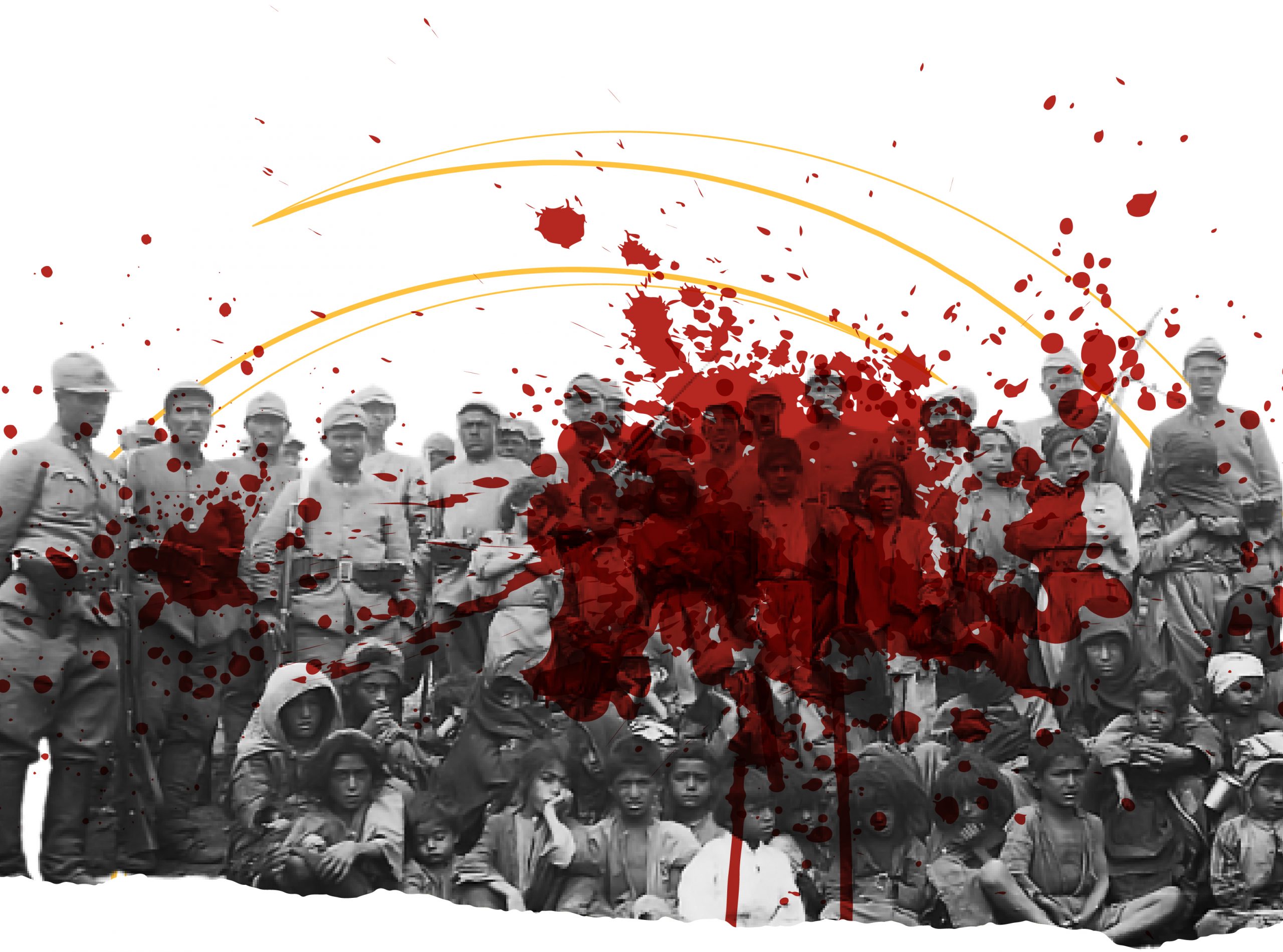
According to an Ottoman historian: They were the best to mutilate corpses
The Ottoman massacre against the Kurds:
The Great Bitlis
The Ottoman historian Evliya Çelebi, born (1611) in Istanbul, is considered a traveler and an Ottoman explorer who traveled independently on missions with the Ottoman armies and expeditions, for forty years, where he started it in 1630 from his hometown, where he recorded his observations on his travels, in his well-known book “Sayhat Namah” book flights in Arabic. Çelebi described one of the most brutal massacres in human history, the “Bitlis” massacre, which was committed against the Kurdish people.
The Turks deliberately defamed the Kurdish nation and accused it of barbarism and backwardness, as they described it as a nation less than the Turkish race, which they consider to be of higher status than other nations. Therefore, Evliya Çelebi described the Kurds as an infidel nation in many of his narrations about them, although he visited their country, lived in the suburbs and admired the country and its diversity and civilization.
Perhaps, and from a historical perspective, it was a mere luck that the traveler Evliya Çelebi was an eyewitness to the horrific crime committed by Sultan Murad IV, out of his jealousy and hatred against the inhabitants of the Kurdish city of Bitlis, a city located on the eastern side of the borders of the Ottoman Empire. Bitlis remained tolerant throughout its history, for example: the Kurds allowed the Armenians to live near them in the city, and to build a number of monasteries. In fact, during the fifteenth century, Bitlis became a center for the production of Armenian manuscripts.
Çelebi recorded the facts of the massacre in his book “Seyahtanama” in 1655, and described that crime that exposed the tyranny of the Ottoman sultans and how they ran the Islamic countries whose misfortune led them to live under the lash of the Turks, so they engaged in all immoral actions, and political and security violence, due to their arrogance and vanity.
Çelebi wrote down his observations and stories through his Ottoman travels, documenting the things he witnessed as he moved from one region to another, from one city to another, and from one castle to another. He detected and recorded all the accurate information about the heritage and folklore of the Kurdish people and their civilization during the Ottoman rule, only to discover some of the hoarded Kurdish heritage, their lost heritage, to be a biased witness to the Ottomans; to eventually obtain sufficient information that no other Turkish or any Ottoman traveler in this span of time, as stated by the researcher Fathallah Hosseini.
The narrations confirm that the Bitlis massacre started when Sultan Murad IV was returning to the Kurdish Diyarbakir to be congratulated after occupying the city of Baghdad in 1639, but Amir Bitlis Abdul Khan did not congratulate him, due to special circumstances, so the Sultan got angry and ordered his military commander, Ahmet Pasha, saying to him: “You must avenge me and take revenge on Yusuf, the leader of the Al-Mazuri clan, and Abdul Khan Al Badlisi.” To immediately kill about 700 Kurds and bring the leader Yusuf a captive after they tortured him, then they executed him. Afterwards, the Ottoman army marched to Mount Sinjar to kill more than 10,000 people, the Ottomans were not satisfied with that, but took most of the livelihood of the Kurds and considered them spoils, while the Ottomans confirmed their tyranny with that crime, establishing a deep-rooted hostility with the Kurds, and Diyarbakir turned into mountains of skulls and severed ears. It is a Turkish policy and custom that they carry out against all those who fight them in order to torture and intimidate others.
Grim details that claimed the lives of more than 10 thousand Kurds.
The massacre was committed after the Kurdish ruler failed to congratulate the Ottoman Sultan after his occupation of Baghdad in 1639.

According to the researcher Hussein Jammo, who said: “Arrogance can be detected in the letters of Ahmet Pasha to the Kurdish prince, which were collected and commented on by the researcher Bawar Nur al-Din in a book devoted to this particular incident; among the threatening sentences used by the Ottoman Pasha: “I pledge to punish and discipline Abdul Khan until he and his sons become slaves of the Ottomans”.
The researcher Rashid Fendi, in his translation of the book of the Journey of Evliya Çelebi in Kurdistan, states that the relationship between Murad IV and the Kurds in the city of Bitlis and its leader Abdul Khan, was filled with jealousy that dominated the heart of the Sultan and was seized by the flames of hatred, although Abdul Khan sent his two sons while they were carrying the Qur’an in their hands, hoping the Sultan would retract his plan of extermination. The battle took place and Evliya Çelebi witnessed its wonders and horrors, so he wrote: “As for our soldiers, given the large number of necks they cut, they reached a limit that their baskets could not fit, so they cut off noses, ears and heads, and each of them aspired to bring 20 ears and 10 noses; one of them had 40 ears and 20 noses. The person who brings more baskets full of severed heads, will get more valuable gifts, while the Kurdish prince’s property was sold in an auction and the soldiers looted as much as they could.”
The Turks deliberately defamed the Kurdish nation and accused it of barbarism and backwardness.



- Evliya Çelebi, A Journey to Kurdistan 1065 AH / 1655 AD, translated by: Rashid Fandy (Dohuk: Khaani Press, 2008).
- Imad Abdel Salam Raouf, Documentary Studies in the Modern History and Civilization of the Kurds (Damascus: Dar Al-Zaman Bookshop Publishing and Distribution, 2012).
- Muhammad Amin Zaki, a summary of the history of the Kurds and Kurdistan from the oldest historical eras until now, translated by: Muhammad Ali Awni, 2nd Edition (Baghdad: The General House of Cultural Affairs, 2005).


